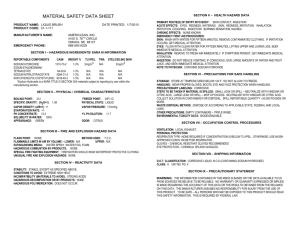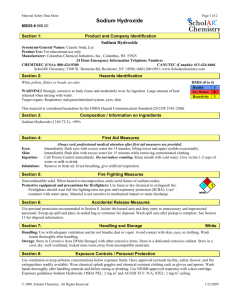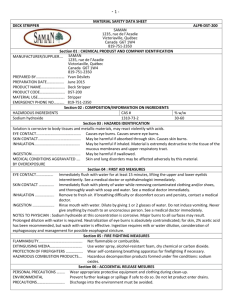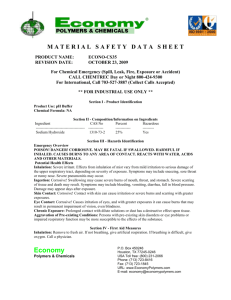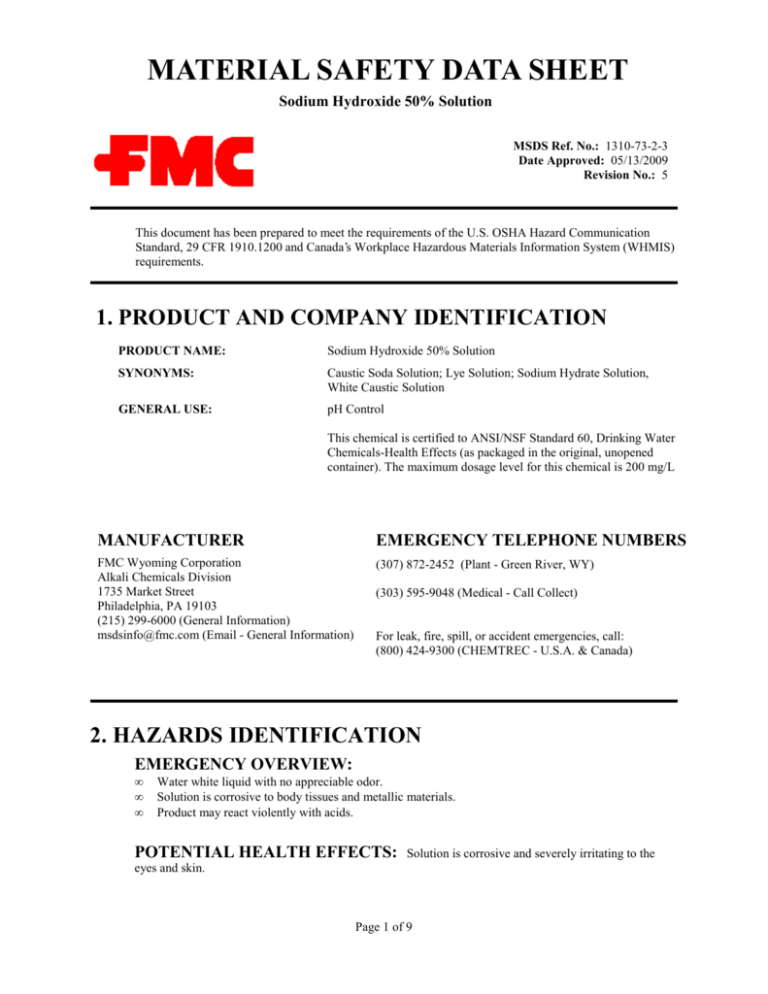
MATERIAL SAFETY DATA SHEET
Sodium Hydroxide 50% Solution
MSDS Ref. No.: 1310-73-2-3
Date Approved: 05/13/2009
Revision No.: 5
This document has been prepared to meet the requirements of the U.S. OSHA Hazard Communication
Standard, 29 CFR 1910.1200 and Canada’s Workplace Hazardous Materials Information System (WHMIS)
requirements.
1. PRODUCT AND COMPANY IDENTIFICATION
PRODUCT NAME:
Sodium Hydroxide 50% Solution
SYNONYMS:
Caustic Soda Solution; Lye Solution; Sodium Hydrate Solution,
White Caustic Solution
GENERAL USE:
pH Control
This chemical is certified to ANSI/NSF Standard 60, Drinking Water
Chemicals-Health Effects (as packaged in the original, unopened
container). The maximum dosage level for this chemical is 200 mg/L
MANUFACTURER
EMERGENCY TELEPHONE NUMBERS
FMC Wyoming Corporation
Alkali Chemicals Division
1735 Market Street
Philadelphia, PA 19103
(215) 299-6000 (General Information)
msdsinfo@fmc.com (Email - General Information)
(307) 872-2452 (Plant - Green River, WY)
(303) 595-9048 (Medical - Call Collect)
For leak, fire, spill, or accident emergencies, call:
(800) 424-9300 (CHEMTREC - U.S.A. & Canada)
2. HAZARDS IDENTIFICATION
EMERGENCY OVERVIEW:
•
•
•
Water white liquid with no appreciable odor.
Solution is corrosive to body tissues and metallic materials.
Product may react violently with acids.
POTENTIAL HEALTH EFFECTS:
Solution is corrosive and severely irritating to the
eyes and skin.
Page 1 of 9
Sodium Hydroxide 50% Solution (1310-73-2-3)
Date: 05/13/2009
MEDICAL CONDITIONS AGGRAVATED:
Skin and lung disorders may be affected
adversely by this material; an individual’s specific medical condition and circumstances of exposure
determine the likelihood of an adverse effect.
3. COMPOSITION / INFORMATION ON INGREDIENTS
Chemical Name
CAS#
Wt.%
EC No.
EC Class
Sodium Hydroxide
1310-73-2
50
215-185-5
C; R35
Water
7732-18-5
50
231-791-2
Not classified
4. FIRST AID MEASURES
EYES:
Immediately flush with water for at least 15 minutes, lifting the upper and lower eyelids
intermittently. See a medical doctor or ophthalmologist immediately.
SKIN: Immediately flush with plenty of water while removing contaminated clothing and/or shoes, and
thoroughly wash with soap and water. See a medical doctor immediately.
INGESTION: Rinse mouth with water. Dilute by giving 1 or 2 glasses of water. Do not induce
vomiting. Never give anything by mouth to an unconscious person. See a medical doctor immediately.
INHALATION: Remove to fresh air. If breathing difficulty or discomfort occurs and persists,
contact a medical doctor.
NOTES TO MEDICAL DOCTOR: Sodium hydroxide at this concentration is corrosive.
Major burns to all surfaces may result. Prolonged dilution with water is required. Neutralization of eye
burns is absolutely contraindicated; for skin, 2% acetic acid has been recommended, but washing with
water is effective. Ingestion requires milk or water dilution, consideration of esphagoscopy and
management for possible esophageal stricture.
5. FIRE FIGHTING MEASURES
EXTINGUISHING MEDIA:
Not applicable
FIRE / EXPLOSION HAZARDS:
Non-combustible
FIRE FIGHTING PROCEDURES:
Not applicable
Page 2 of 9
Sodium Hydroxide 50% Solution (1310-73-2-3)
FLAMMABLE LIMITS:
Date: 05/13/2009
Not applicable
HAZARDOUS COMBUSTION PRODUCTS:
SENSITIVITY TO IMPACT:
None
Not Sensitive
SENSITIVITY TO STATIC DISCHARGE:
Not Sensitive
6. ACCIDENTAL RELEASE MEASURES
RELEASE NOTES: Wear personal protective equipment as recommended in Section 8,
"Exposure Controls/Personal Protection" below.
Contain spill using absorbent material and place in an approved container.
Dispose of according to the method outlined in Section 13, "Disposal Considerations" below.
7. HANDLING AND STORAGE
HANDLING:
During handling of liquid, prevent contact with skin and eyes by using adequate
personal protective equipment (see Section 8, "Exposure Controls/Personal Protection" below). If the
release of airborne material is likely, exhaust ventilation and/or respiratory protection may also be
necessary.
STORAGE:
Store in closed containers away from sources of heat.
COMMENTS:
Use only in systems, processes and procedures in which effective ventilation has
been provided to meet established exposure limits.
8. EXPOSURE CONTROLS / PERSONAL PROTECTION
EXPOSURE LIMITS
Chemical Name
ACGIH
OSHA
Sodium Hydroxide
2 mg/m3 (ceiling)
2 mg/m3 (PEL)
Supplier
ENGINEERING CONTROLS: Adequate engineering controls and/or personal protective
equipment must be used to prevent contact with skin and eyes. Engineering controls and/or respirators may
be necessary when the generation of airborne mists or fogs are possible.
Page 3 of 9
Sodium Hydroxide 50% Solution (1310-73-2-3)
Date: 05/13/2009
PERSONAL PROTECTIVE EQUIPMENT
EYES AND FACE:
Chemical goggles (and face shield if necessary) should be worn to
prevent contact.
RESPIRATORY:
When exposure above the established standard is likely, a respiratory
protection program that complies with OSHA General Industry Standard 1910.134 should be
implemented. Wear full face-piece respirators approved by MSHA / NIOSH if mists are expected.
PROTECTIVE CLOTHING:
Rubber or vinyl apron. Rubber boots or rubber
overshoes.
GLOVES:
Impervious rubber or vinyl gloves with gauntlets. Thoroughly wash the outside
of gloves with soap and water prior to removal. Inspect regularly for leaks.
COMMENTS:
The information noted above provides general guidance for handling this product. Specific work
environments and material handling practices will dictate the selection and use of personal protection
equipment (PPE).
9. PHYSICAL AND CHEMICAL PROPERTIES
ODOR:
No appreciable odor
APPEARANCE:
Water white liquid
AUTOIGNITION TEMPERATURE:
Not applicable
BOILING POINT:
145 °C (293 °F)
COEFFICIENT OF OIL / WATER:
Not applicable
EVAPORATION RATE:
(butyl acetate = 1) Not available
FLASH POINT:
Non-combustible
FREEZING POINT:
4.4°C (40°F)
ODOR THRESHOLD:
Not applicable
OXIDIZING PROPERTIES:
Not available
PERCENT VOLATILE:
Not applicable
pH:
(as is) 13.7
SOLUBILITY IN WATER:
Infinite
SPECIFIC GRAVITY:
1.53 @ 15.5°C (60°F) (water = 1)
VAPOR DENSITY:
Not applicable
VAPOR PRESSURE:
6.33 mm Hg @ 40 °C (104 °F)
COMMENTS:
Page 4 of 9
Sodium Hydroxide 50% Solution (1310-73-2-3)
Date: 05/13/2009
pH (1% solution): 13.0
10. STABILITY AND REACTIVITY
CONDITIONS TO AVOID:
Contact with acids, flammable liquids, organic
halogen compounds, nitro compounds, and
amphoteric metals, such as aluminum, magnesium
and zinc.
STABILITY:
Slightly reactive
POLYMERIZATION:
Will not occur
INCOMPATIBLE MATERIALS:
Acids, flammable liquids, organic halogen
compounds, nitro compounds, and amphoteric
metals, such as aluminum, magnesium and zinc.
HAZARDOUS DECOMPOSITION PRODUCTS:
None
11. TOXICOLOGICAL INFORMATION
EYE EFFECTS:
SKIN EFFECTS:
DERMAL LD50:
Severely irritating, corrosive (rabbit) [RTECS 1986, NIOSH 1975]
Severely irritating, corrosive (rabbit) [RTECS 1986, PB 234-899 1974]
Corrosive
ORAL LD50: 400 mg/kg (rabbit)
LDLo [PB 234-899 1974]
INHALATION LC50:
Corrosive
TARGET ORGANS:
Skin, eyes, mucous membranes
ACUTE EFFECTS FROM OVEREXPOSURE:
Sodium hydroxide is corrosive and
may produce severe eye, skin and respiratory tract irritation and upper gastrointestinal tract damage.
Ingestion of concentrated solutions has caused death in animals and humans. [Gosselin, Smith & Hodge,
1984; PB 234-899 1974]
CHRONIC EFFECTS FROM OVEREXPOSURE:
Sodium hydroxide may produce
inflammation of the eyes, skin, and mucous membranes. Esophageal carcinoma at the site of a chronic lye
stricture has been reported. [Gosselin , Smith & Hodge 1984]
Page 5 of 9
Sodium Hydroxide 50% Solution (1310-73-2-3)
Date: 05/13/2009
CARCINOGENICITY:
NTP:
Not listed
IARC:
Not listed
OSHA:
Not listed
OTHER:
Not Listed (ACGIH)
12. ECOLOGICAL INFORMATION
ECOTOXICOLOGICAL INFORMATION:
Bluegill sunfish: 48-hour LC50 = 99 mg/L
Mosquito fish: 96-hour LC50 = 125 mg/L
Brown shrimp (Crangon crangon): 48-hour LC50 = 30 - 100 mg/L
The damaging effects are mostly a consequence of the increase in pH. The upper pH limit tolerated by most
freshwater fish is 8.4; the pH must generally be greater than 9 before the aqueous environment becomes
lethal for fully developed fish. Freshwater algae are destroyed above pH 8.5. Concentrations of 20 to 100
mg/L have been reported to kill salmon, trout, carp and crayfish. [Ref. , Environment Canada,
Environmental Protection Service, Sodium Hydroxide Environmental and Technical Information for
Problem Spills. June 1984]
CHEMICAL FATE INFORMATION:
The pH effect of sodium hydroxide in water is
naturally reduced by the absorption of atmospheric carbon dioxide. This reduction is also effected by
dilution with water and by the natural acidity of a given water body. There is no degradation of sodium
hydroxide in waters, only loss by absorption or through chemical neutralization.
13. DISPOSAL CONSIDERATIONS
DISPOSAL METHOD:
Dispose of in accordance with all local, state and federal environmental
rules and regulations. Check the pH of the waste to be disposed, if it is greater than 12.5 it must be handled
as a RCRA hazardous waste.
14. TRANSPORT INFORMATION
U.S. DEPARTMENT OF TRANSPORTATION (DOT)
PROPER SHIPPING NAME:
Sodium Hydroxide Solution
PRIMARY HAZARD CLASS / DIVISION:
8
UN/NA NUMBER:
UN 1824
PACKING GROUP:
II
Page 6 of 9
Sodium Hydroxide 50% Solution (1310-73-2-3)
Date: 05/13/2009
LABEL(S):
Corrosive
PLACARD(S):
Corrosive
ADDITIONAL INFORMATION:
Sodium hydroxide is in an "RQ" quantity
when this material meets or exceeds 2500
pounds per bulk package.
49 STCC Number: 4935240
INTERNATIONAL MARITIME DANGEROUS GOODS (IMDG)
Sodium Hydroxide Solution
PROPER SHIPPING NAME:
INTERNATIONAL CIVIL AVIATION ORGANIZATION (ICAO) /
INTERNATIONAL AIR TRANSPORT ASSOCIATION (IATA)
Sodium Hydroxide Solution
PROPER SHIPPING NAME:
OTHER INFORMATION:
Cool containers with water if exposed to fire or excessive heat conditions.
15. REGULATORY INFORMATION
UNITED STATES
SARA TITLE III (SUPERFUND AMENDMENTS AND REAUTHORIZATION ACT)
SECTION 302 EXTREMELY HAZARDOUS SUBSTANCES (40 CFR 355, APPENDIX A):
Not listed
SECTION 311 HAZARD CATEGORIES (40 CFR 370):
Immediate (Acute) Health Hazard
SECTION 312 THRESHOLD PLANNING QUANTITY (40 CFR 370):
The Threshold Planning Quantity (TPQ) for this product, if treated as a mixture, is 10,000 lbs;
however, this product contains the following ingredients with a TPQ of less than 10,000 lbs.:
None
SECTION 313 REPORTABLE INGREDIENTS (40 CFR 372):
This product does not contain any toxic chemicals subject to the reporting requirements of
Section 313, Title III of the SARA (Superfund Amendments and Reauthorization Act) of
1986.
Page 7 of 9
Sodium Hydroxide 50% Solution (1310-73-2-3)
Date: 05/13/2009
CERCLA (COMPREHENSIVE ENVIRONMENTAL RESPONSE COMPENSATION AND
LIABILITY ACT)
CERCLA DESIGNATION & REPORTABLE QUANTITIES (RQ) (40 CFR 302.4):
Listed
Chemical Name
Sodium Hydroxide
RQ
1,000 lb
Category C
TSCA (TOXIC SUBSTANCE CONTROL ACT)
TSCA INVENTORY STATUS (40 CFR 710):
All components are listed or exempt.
CANADA
WHMIS (WORKPLACE HAZARDOUS MATERIALS INFORMATION SYSTEM):
This product has been classified in accordance with the hazard criteria of the Controlled Products
Regulations and the MSDS contains all the information required by the Controlled Products
Regulations.
Hazard Classification / Division: E
Ingredient Disclosure List:
Listed
Domestic Substance List:
All components are listed or exempt.
EU EINECS NUMBERS:
215-185-5 (sodium hydroxide)
HAZARD AND RISK PHRASE DESCRIPTIONS:
EC Symbols:
C
(Corrosive)
EC Risk Phrases:
R35
(Causes severe burns.)
16. OTHER INFORMATION
HMIS
Health
3
Flammability
0
Physical Hazard
1
Personal Protection (PPE)
J
Protection = J (Safety goggles, gloves, apron & combination dust & vapor respirator)
Page 8 of 9
Sodium Hydroxide 50% Solution (1310-73-2-3)
Date: 05/13/2009
HMIS = Hazardous Materials Identification System
Degree of Hazard Code:
4 = Severe
3 = Serious
2 = Moderate
1 = Slight
0 = Minimal
NFPA
Health
Flammability
Reactivity
Special
No special requirements
3
0
1
None
NFPA (National Fire Protection Association)
Degree of Hazard Code:
4 = Extreme
3 = High
2 = Moderate
1 = Slight
0 = Insignificant
REVISION SUMMARY:
This MSDS replaces Revision #4, dated January 26, 2004.
Changes in information are as follows:
Section 1 (Product and Company Identification)
Section 8 (Exposure Controls / Personal Protection)
Section 14 (Transport Information)
Section 15 (Regulatory Information)
Section 16 (Other Information)
FMC - Trademark of FMC Corporation
© 2009 FMC Corporation. All Rights Reserved.
FMC Corporation believes that the information and recommendations contained herein (including data and
statements) are accurate as of the date hereof. NO WARRANTY OF FITNESS FOR ANY PARTICULAR
PURPOSE, WARRANTY OF MERCHANTABILITY, OR ANY OTHER WARRANTY, EXPRESSED
OR IMPLIED, IS MADE CONCERNING THE INFORMATION PROVIDED HEREIN. The information
provided herein relates only to the specific product designated and may not be applicable where such
product is used in combination with any other materials or in any process. It is a violation of Federal law to
use this product in a manner inconsistent with its labeling. Further, since the conditions and methods of use
are beyond the control of FMC Corporation, FMC Corporation expressly disclaims any and all liability as
to any results obtained or arising from any use of the product or reliance on such information.
Page 9 of 9



